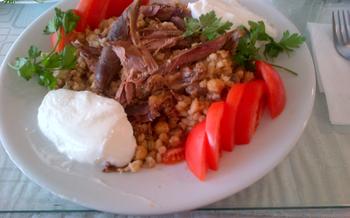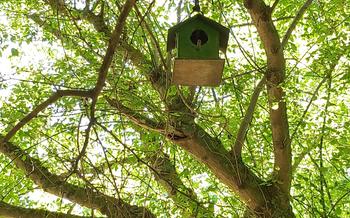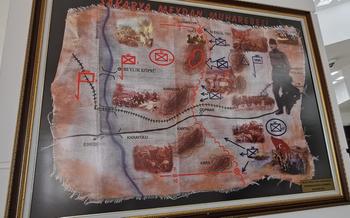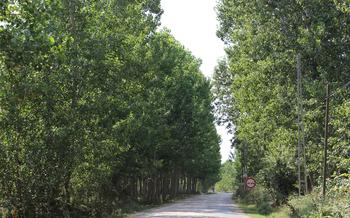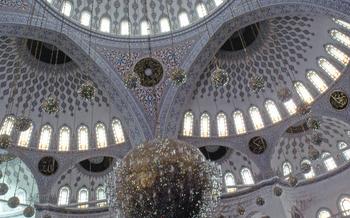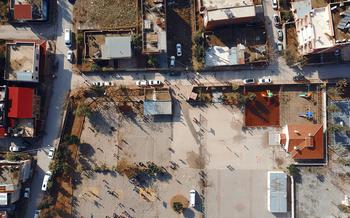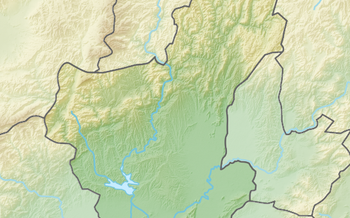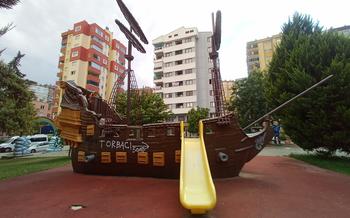
Büyük Imaret Mosque
- Historical Significance
- Architectural Marvel
- Symbol of Faith
- UNESCO World Heritage Site
- Location and Accessibility
- Visiting Hours and Dress Code
- Guided Tours and Local Experts
- Photography and Videography
- Local Cuisine and Restaurants
- Shopping for Souvenirs
- Nearby Attractions and Activities
- Cultural and Historical Context
- Restoration and Preservation Efforts
- Insider Tip:
Historical Significance
The Büyük Imaret Mosque, a remarkable architectural masterpiece in Tokat, Turkey, invites visitors to delve into the rich tapestry of Islamic history and Seljuk heritage. Constructed during the reign of the Seljuk Sultan Alaeddin Keykubat I in the 13th century, the mosque stands as a testament to the architectural brilliance of the Seljuk era. Its historical significance extends beyond its architectural splendor, as it served as a prominent center of learning and religious practices for centuries, fostering a deep connection between faith, education, and community within the heart of Tokat.
Architectural Marvel
The Büyük Imaret Mosque stands as a testament to the architectural brilliance of the Seljuk period. Its grand entrance, adorned with intricate carvings and calligraphy, welcomes visitors into a world of artistic beauty. The courtyard, with its serene atmosphere, features a mesmerizing fountain that adds to the tranquility of the space.
Inside the mosque, the prayer hall is a masterpiece of Islamic architecture. The soaring dome, supported by elegant pillars, creates a sense of awe and grandeur. The walls are adorned with intricate tilework and calligraphy, showcasing the exceptional craftsmanship of the Seljuk artisans. The mihrab, the niche indicating the direction of Mecca, is a focal point of the prayer hall, featuring exquisite carvings and colorful tiles.
Every corner of the mosque reveals a new architectural treasure, from the delicate stained-glass windows to the intricate geometric patterns on the ceiling. The Büyük Imaret Mosque is a true architectural marvel, showcasing the fusion of Seljuk traditions with Islamic influences.
Symbol of Faith
As a symbol of Islamic faith and devotion, the Büyük Imaret Mosque holds a significant place in the hearts of Tokat's Muslim community. It serves as a gathering place for daily prayers, congregational gatherings, and religious celebrations. During the holy month of Ramadan, the mosque comes alive with special prayers, Taraweeh, and Iftar meals, fostering a sense of unity and spirituality among the faithful.
The mosque's architectural design and interior elements reflect the rich symbolism and traditions of Islam. The qibla wall, adorned with intricate mihrab, indicates the direction of Mecca, the holiest city in Islam. The minarets, reaching towards the sky, symbolize the call to prayer and the connection between heaven and earth.
Visitors to the mosque can observe the daily rituals and practices of Muslim worshippers. The melodious recitation of the Quran, the rhythmic movements of prayer, and the communal spirit create a serene and awe-inspiring atmosphere. By understanding the significance of the mosque as a symbol of faith, visitors gain a deeper appreciation for the cultural and religious heritage of Tokat.
UNESCO World Heritage Site
The Büyük Imaret Mosque holds a prestigious position as a UNESCO World Heritage Site, recognized for its exceptional cultural and historical significance. This designation highlights the mosque's outstanding universal value, which extends beyond national borders and resonates with people worldwide. To be inscribed on the World Heritage List, a site must meet at least one of ten selection criteria established by UNESCO.
The Büyük Imaret Mosque fulfills several of these criteria, including its architectural uniqueness and its representation of a significant stage in human history. The mosque's distinctive design, intricate details, and innovative features exemplify the architectural achievements of the Seljuk period. Moreover, its role as a center of learning and religious practices underscores its contribution to the development of Islamic civilization.
Preserving and protecting such heritage sites is crucial for several reasons. First, they serve as tangible links to the past, providing valuable insights into the cultural evolution of societies. Second, these sites contribute to cultural diversity and foster a sense of global interconnectedness. Third, they promote sustainable tourism, generating economic benefits for local communities while raising awareness of cultural preservation.
As visitors explore the Büyük Imaret Mosque, they become part of a global movement dedicated to safeguarding and cherishing our shared heritage. They contribute to the preservation of this architectural masterpiece and ensure that future generations can continue to appreciate its beauty, significance, and enduring legacy.
Location and Accessibility
The Büyük Imaret Mosque is conveniently located in the heart of Tokat, a city with a rich history and cultural heritage. To reach the mosque, visitors can take advantage of the city's well-connected transportation system. The mosque is within walking distance from the city center and is easily accessible by public transportation. Visitors can take a bus or a taxi from any part of the city to reach the mosque. For those driving, ample parking is available in the vicinity of the mosque. The mosque is situated on a prominent street, making it easy to locate. Its grand entrance and towering minarets can be seen from afar, inviting visitors to explore its architectural wonders and spiritual significance.
Visiting Hours and Dress Code
Visiting Hours:
Büyük Imaret Mosque, like most mosques in Turkey, welcomes visitors during specific hours each day. Generally, the mosque is open from morning until sunset, with the exception of prayer times. During these times, non-Muslims are kindly requested to wait outside until the prayers conclude. It is advisable to check with the local authorities or the mosque's administration for the exact visiting hours, as they might vary depending on the time of year or special events.
Dress Code:
When entering a mosque, it is important to respect local customs and traditions by dressing modestly. For men, this means wearing long pants and a shirt that covers the shoulders. Women are expected to cover their heads with a headscarf or shawl, and wear loose-fitting clothing that covers their arms and legs. It is also advisable to remove shoes before entering the prayer hall or mosque interior.
Respectful Behavior:
While visiting the mosque, it is essential to maintain a respectful and quiet demeanor. Avoid loud conversations or disruptive behavior, as the mosque is a place of worship and contemplation. Photography and videography are generally allowed, but it is crucial to be mindful of other worshippers and seek permission before taking any photos or videos.
Guided Tours and Local Experts
To truly delve into the depths of the mosque's history and significance, consider booking a guided tour. Knowledgeable guides can provide captivating insights, anecdotes, and historical context that bring the mosque to life. They can point out hidden details, explain the symbolism behind the architecture, and share stories of the people who have worshipped and studied within these walls.
Local experts, with their deep understanding of the mosque and its place in Turkish culture, can offer a unique perspective. They can share insights into the daily life of the mosque, the rituals and traditions practiced by the community, and the role of the mosque in shaping the identity of Tokat. Hiring a local expert is an investment in a richer and more meaningful experience.
Photography and Videography
When visiting the Büyük Imaret Mosque, it's important to be respectful of the sacred nature of the site. Photography and videography are generally permitted, but visitors should be mindful of the following guidelines:
-
Flash photography and tripods are not allowed inside the mosque. These can be disruptive to other visitors and may damage the delicate interior of the mosque.
-
Visitors should avoid taking photos or videos of people who are praying or engaged in religious rituals. It's important to respect their privacy and maintain a peaceful atmosphere within the mosque.
-
When taking photos or videos, be sure to capture the mosque's architectural details and unique features. The intricate tilework, calligraphy, and decorative elements are all worthy of capturing.
-
It's a good idea to ask permission before taking photos or videos of people inside the mosque. This is especially important if you're taking photos for commercial purposes.
-
Remember to turn off the sound on your camera or phone before entering the mosque. This will help to minimize distractions and maintain a respectful atmosphere.
Local Cuisine and Restaurants
After exploring the architectural marvels and spiritual significance of the Büyük Imaret Mosque, visitors can satisfy their taste buds with traditional Turkish cuisine at nearby restaurants or cafes. The Tokat region is renowned for its delectable dishes, such as Tokat kebabı, a succulent grilled meat dish, and Tokat böreği, a flaky pastry filled with cheese, meat, or vegetables.
For a true culinary adventure, venture into the local markets or shops around the mosque, where visitors can browse an array of spices, sweets, and handicrafts. Engaging with local vendors and bargaining for unique souvenirs is a delightful experience that adds a personal touch to your visit.
Shopping for Souvenirs
After your visit, immerse yourself in the vibrant local markets or shops near the Büyük Imaret Mosque, where you can find a treasure trove of souvenirs to remember your time in Tokat. Discover unique handicrafts, traditional Turkish textiles, and exquisite ceramics that reflect the city's rich cultural heritage. Look for the distinctive Tokat rugs, renowned for their intricate designs and vibrant colors. Bargaining is a part of the shopping experience, so don't be afraid to engage with the friendly vendors and negotiate a fair price. Whether you're searching for a special gift for loved ones back home or a memento for yourself, the markets surrounding the mosque offer an authentic and rewarding shopping experience.
Nearby Attractions and Activities
After exploring the Büyük Imaret Mosque, visitors can venture into the city of Tokat to discover a wealth of other historical and cultural attractions. The Tokat Castle, perched atop a hill, offers panoramic views of the city and the surrounding landscapes. The Taşhan, an old caravanserai, has been transformed into a vibrant bazaar, where shoppers can find traditional Turkish handicrafts, carpets, and jewelry.
For those interested in history, the Tokat Museum houses a collection of artifacts and exhibits that showcase the city's rich past. The Gök Medrese, another Seljuk-era building, is a testament to the city's architectural heritage and now serves as a cultural center. Nature enthusiasts can escape to the nearby Tokat Waterfall, where they can witness the cascading waters and enjoy the tranquil surroundings.
Combining a visit to the Büyük Imaret Mosque with these nearby attractions provides visitors with a comprehensive experience of Tokat's historical, cultural, and natural wonders, ensuring a memorable and enriching journey through this ancient city.
Cultural and Historical Context
The Büyük Imaret Mosque stands as a testament to the rich cultural and historical heritage of Tokat, a city that has been a melting pot of civilizations throughout history. Built during the Seljuk period, the mosque embodies the architectural prowess and devotion of the era. Its intricate tilework, elegant calligraphy, and harmonious design reflect the artistic and cultural achievements of the Seljuk Turks.
Beyond its architectural significance, the mosque holds deep spiritual and communal value for the people of Tokat. It has served as a center of Islamic learning and worship for centuries, fostering a sense of unity and faith among the local community. The mosque's minarets, reaching towards the heavens, symbolize the connection between the earthly and the divine, reminding visitors of the spiritual essence that permeates the city.
The mosque's enduring presence in Tokat has shaped the city's identity and cultural fabric. It has witnessed countless historical events, from the rise and fall of empires to the everyday lives of ordinary citizens. Its walls hold stories of devotion, celebration, and contemplation, weaving together the tapestry of Tokat's rich cultural heritage.
Restoration and Preservation Efforts
The Büyük Imaret Mosque has undergone several restoration and preservation efforts throughout its history to maintain its architectural integrity and historical significance. In the 19th century, the mosque was extensively renovated and restored under the supervision of the Ottoman architect, Ali Rıza Bey. This restoration involved repairing structural damage, reinforcing the foundations, and restoring the intricate tilework and decorative elements.
In the 20th century, the mosque underwent further restoration and preservation efforts under the guidance of the Turkish Ministry of Culture and Tourism. These efforts focused on conserving the mosque's original features, including the intricate stone carvings, calligraphy, and tilework. The restoration team also addressed structural issues, such as cracks and water damage, to ensure the mosque's long-term stability.
One of the most significant restoration projects was undertaken in the 1980s, which involved a comprehensive cleaning and restoration of the mosque's interior and exterior. This project aimed to remove centuries of accumulated dirt and grime, revealing the mosque's vibrant colors and intricate details. The restoration team also repaired damaged tiles and replaced missing or worn-out elements with authentic materials.
The ongoing restoration and preservation efforts at the Büyük Imaret Mosque are a testament to the importance of preserving Turkey's cultural heritage. These efforts ensure that the mosque remains a symbol of Tokat's rich history and architectural legacy, while also providing a place of worship and spiritual reflection for the local community.
Insider Tip:
For a truly memorable experience, visit the Büyük Imaret Mosque during the early morning or late afternoon, when the soft sunlight casts a warm glow on its ancient walls. As you step inside, take a moment to find the hidden courtyard, a serene oasis tucked away from the bustling city. Here, you can sit in tranquil contemplation, surrounded by the intricate tilework and the gentle sound of birdsong. Remember to dress respectfully, covering your shoulders and knees, and be mindful of the local customs and traditions when visiting this sacred space.
